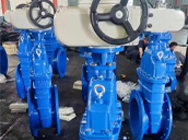Understanding Offset Butterfly Valve Design and Its Applications in Modern Engineering
Understanding Offset Butterfly Valves A Comprehensive Overview
Offset butterfly valves are a crucial component in various industrial applications, renowned for their efficient flow control and design flexibility. This article delves into the intricacies of offset butterfly valves, including their operational principles, advantages, and applications.
What is an Offset Butterfly Valve?
An offset butterfly valve features a disc that rotates around a shaft positioned off-center, or offset, from the pipe’s centerline. This design differentiates it from traditional butterfly valves, where the shaft is aligned with the pipe’s center. The offset mechanism allows for improved sealing and performance under different operational conditions.
How Does It Work?
The key to the operation of an offset butterfly valve lies in its unique design. When actuated, the disc rotates smoothly to either open or close the flow passage. In the closed position, the disc presses against the valve seat, creating a tight seal that minimizes leakage. The off-centered disc design reduces the stress on the sealing elements, thereby prolonging the valve's lifespan. Additionally, the geometry of the offset allows for better throttling capabilities, making it suitable for applications requiring precise flow regulation.
Advantages of Offset Butterfly Valves
1. Improved Seal Integrity The offset design enhances the sealing mechanism, reducing the likelihood of leaks and providing a more reliable operation, particularly in high-pressure applications.
2. Lower Operating Torque Due to the unique disc alignment, offset butterfly valves generally require less force to operate compared to traditional designs. This leads to lower energy consumption and reduces wear on the actuator.
3. Space Efficiency The compact structure of offset butterfly valves makes them ideal for installations where space is limited. Their lightweight design also contributes to easier handling and installation.
offset butterfly valve

4. Versatility These valves can handle various media, including water, oil, gas, and even corrosive substances, making them suitable for diverse industries such as water treatment, oil and gas, and chemical processing.
5. Cost-Effectiveness Offset butterfly valves tend to be more economical in terms of both initial investment and maintenance costs, offering a favorable return on investment for industrial operations.
Applications
Offset butterfly valves are widely used across multiple sectors
- Water and Wastewater Treatment They control the flow of water and wastewater in treatment facilities, ensuring efficient and effective processing.
- Oil and Gas In pipelines, these valves help regulate the transport of oil and gas, maintaining the integrity of operations in potentially hazardous environments.
- Chemical Processing Their ability to handle corrosive and aggressive media makes them indispensable in chemical plants, where precise flow control is critical.
- HVAC Systems In heating, ventilation, and air conditioning systems, offset butterfly valves help maintain proper airflow and temperature control.
Conclusion
Offset butterfly valves stand out for their efficiency, versatility, and reliability in flow control applications. Their innovative design and operational benefits make them a preferred choice for industries requiring robust and effective valve solutions. As technology advances, the role of offset butterfly valves is likely to expand, contributing even more to efficient industrial operations. Understanding these valves better will empower engineers and managers to make informed decisions in their application and maintenance, ensuring optimal performance in their respective fields.
-
The Key to Fluid Control: Exploring the Advantages of Ball Valves in Industrial SystemsNewsJul.09,2025
-
The Versatile World of 1, 2, and 3 Piece Ball ValvesNewsJul.09,2025
-
Stainless Steel Ball Valves: The Ideal Choice for Efficient Flow ControlNewsJul.09,2025
-
Optimizing Fluid Control with Ball Float ValvesNewsJul.09,2025
-
Manual Gate Valves: Essential for Control and EfficiencyNewsJul.09,2025
-
Everything You Need to Know About Butterfly ValvesNewsJul.09,2025
-
The Versatility of Wafer Type Butterfly ValvesNewsJul.08,2025




